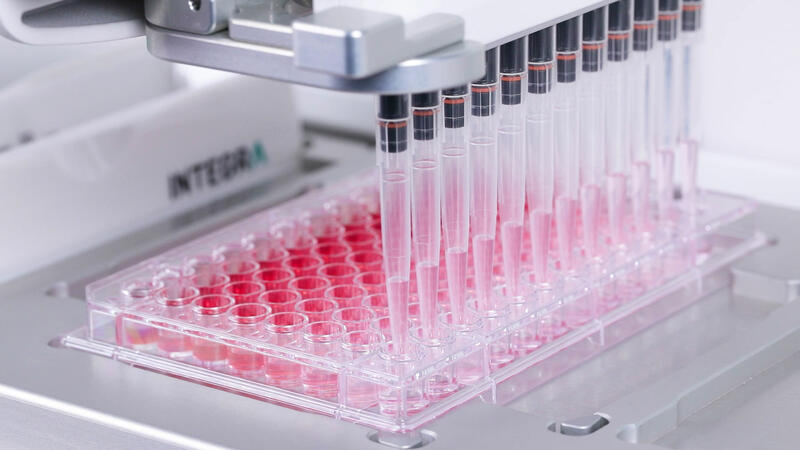How to culture bacteria
Written by Éva Mészáros
12. December 2022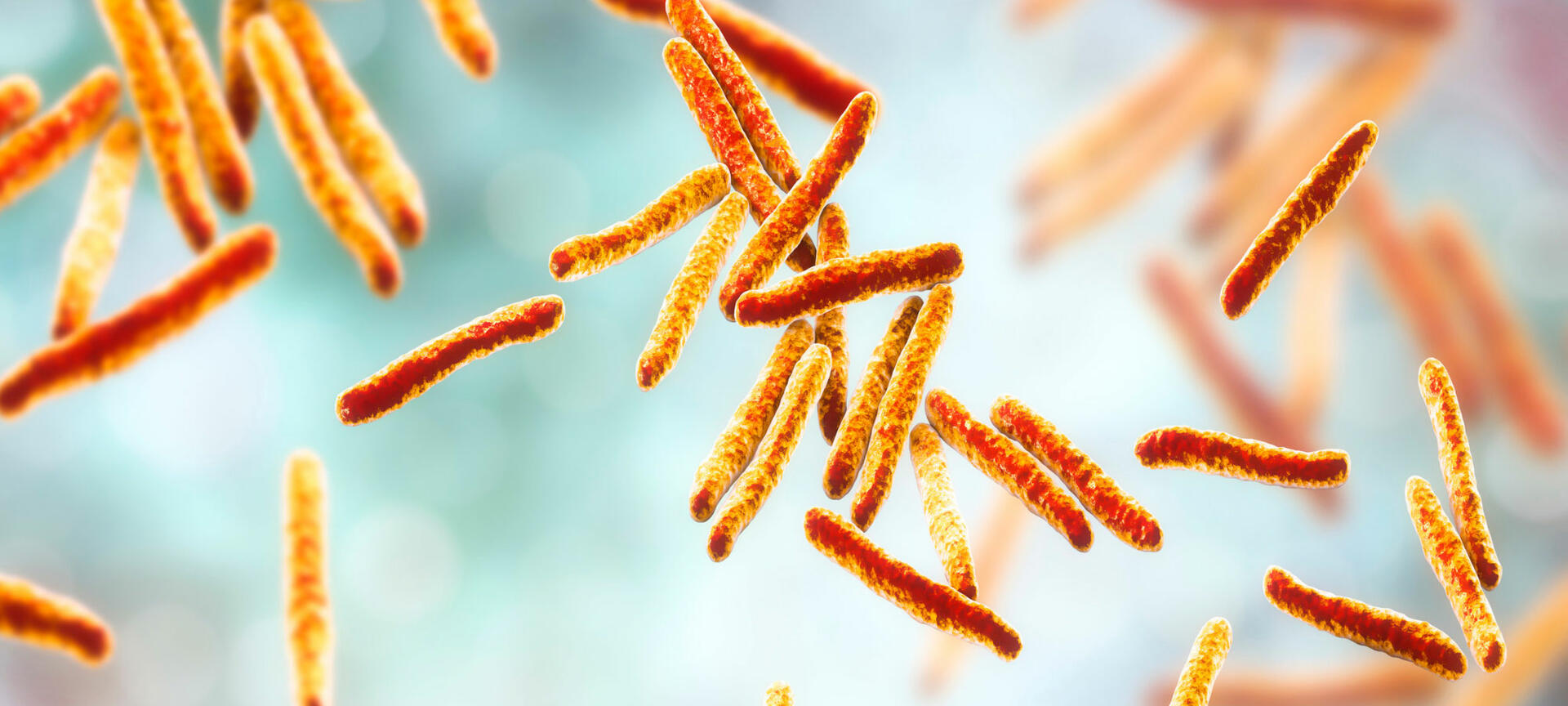
Bacteria are not visible to the naked eye, but they are everywhere. This is clearly illustrated by the fact that, while humanity accounts for only about 0.06 gigatons of the Earth's total biomass, there are an estimated 70 gigatons of bacteria.1 Culturing these omnipresent microorganisms, however, can be a difficult task. To date, the vast majority of bacteria cannot be successfully grown in the lab,2 and consequently cannot be officially named.3 Common reasons for this include not being able to provide them with the required nutrients, a dependency on other bacterial species to grow,4 and that some species enter a viable but non-culturable state in adverse circumstances, meaning that they will be unculturable in vitro until they have been resuscitated.5
Despite these challenges, countless lab professionals are working in the field of bacterial cultivation, as these microorganisms play a crucial role in many sectors, such as the development of new antibiotics, diagnostics, ecology, food production, and even bioengineering. If you're one of them, we've compiled extensive information on the most important culturing parameters, common procedures, and useful troubleshooting tips for you in this article.
Table of contents
What is a bacterial culture?
Bacterial culture
Bacterial culture refers to the process of growing bacteria in or on a medium in a lab environment. The culturing parameters vary between the different bacterial species. One of the most important factors is oxygen. Depending on whether your bacteria need oxygen or not, you have to grow the bacterial cells in an aerobic or anaerobic culture.
Aerobic vs. anaerobic bacterial culture
The cellular respiration of bacteria can either be aerobic, anaerobic or both, allowing you to classify every species into one of the following categories6:
- Obligate aerobes require oxygen for their cellular respiration and cannot survive without it.6
- Microaerophiles require oxygen, but are unable to grow at normal atmospheric concentrations. This is because they are adapted to environments with low amounts of oxygen.7
- Facultative anaerobes prefer oxygen-rich environments, but can switch from aerobic to anaerobic respiration in environments that lack oxygen.6
- Obligate anaerobes don't require oxygen for their cellular respiration – it can even be toxic to them.6
- Aerotolerant anaerobes don't require oxygen for their cellular respiration, but are insensitive to it. This means that they will grow in oxygen-rich environments, although without using it.8
The culture conditions need to be adapted according to the type of bacteria that you want to grow. Providing bacteria with an oxygen-rich environment shouldn't be an issue, but protecting your bacteria from oxygen during culturing steps can be challenging. It requires devices capable of creating oxygen-free environments – such as anaerobic glove boxes – and a special type of medium that has had the oxygen removed before heat sterilization.9
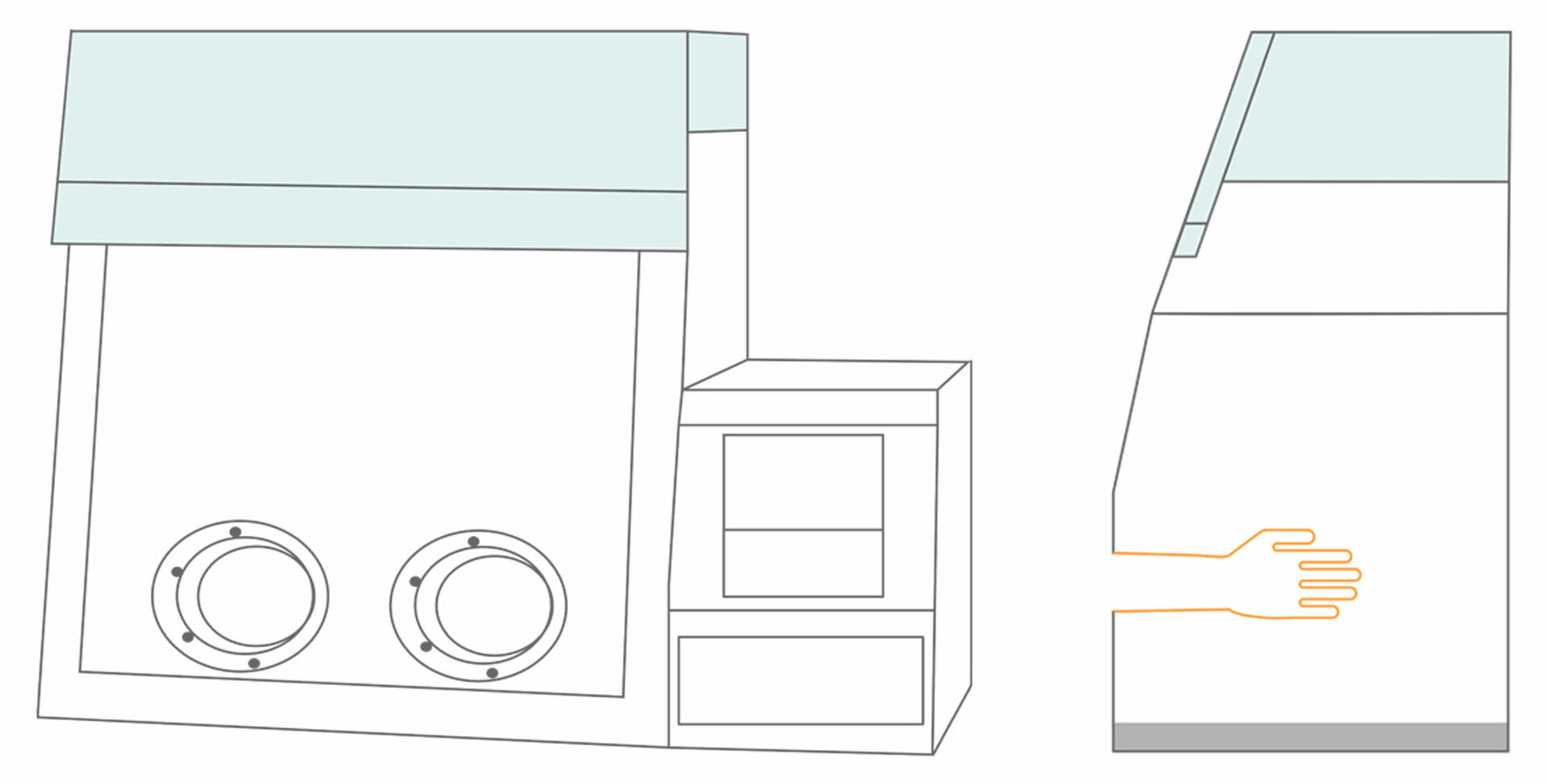
Types of microbial media
Besides the right concentration of oxygen, bacteria need suitable nutrients for their growth. These nutrients are provided by the culture medium, which can be divided into one of three groups based on its consistency: liquid, semi-solid and solid.
Liquid, semi-solid and solid media
The difference between liquid, semi-solid and solid media is the agar concentration. Liquid or broth media don't contain agar at all, and are usually filled into capped tubes. The same applies to semi-solid media that contain a small percentage – about 0.5 % – of agar to give them a ‘custard-like’ consistency.10 Recipes for solid media usually contain between 1.5 and 2 % agar. Solid media can also be filled into tubes, as they only solidify once cooled down. However, you need to tilt the tubes to create a larger surface area for bacterial inoculation. Alternatively, you can fill solid media into Petri dishes, offering an even larger surface for growth.10
When to use which type of medium depends on your application. Solid media are useful if you want to obtain a pure bacterial culture from a sample that contains several bacterial species or strains. More information on this can be found in the section 'How to get a pure culture'. Moreover, solid media allow you to observe the characteristics of the colonies that form during incubation, enabling you to determine the types of bacterial species and strains present in your sample.11
Semi-solid media are mainly used to study bacterial motility. After inserting an inoculating needle into the center of a tube filled with semi-solid medium and incubating it, motile bacteria will have grown throughout the entire medium, whereas non-motile bacteria will only have grown in the inoculated area.12
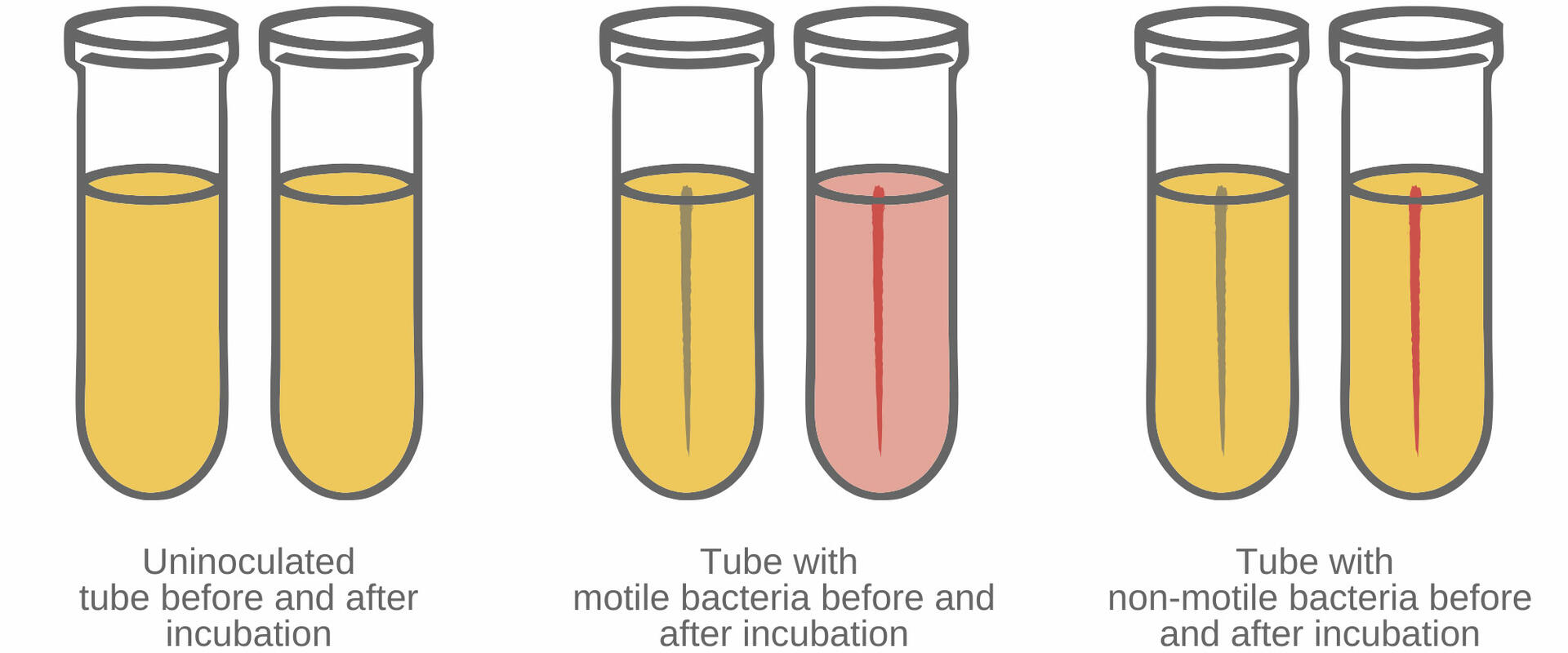
Liquid or broth media can be useful if you need to grow a large number of bacteria for downstream applications, such as plasmid purification. As the bacterial growth is only limited by their concentration in the medium, and not by the available surface area, more bacteria can grow in a tube filled with a liquid medium than on the surface of an agar slant tube or a Petri dish filled with a solid medium. Please note that liquid bacterial cultivation can also be performed in Erlenmeyer flasks instead of tubes. In this case, however, you need a shaker incubator to ensure a constant oxygen supply throughout the medium when culturing aerobic bacteria.
If you are looking for specific solid, semi-solid or liquid media recipes for your bacteria of interest, we recommend checking the German Collection of Microorganisms catalog, which lists more than 26000 bacteria, and includes cultivation conditions and links to media recipes.
Defined, undefined and minimal media
A second way to classify culture media is according to their composition. Defined or synthetic media have a known chemical composition and, consequently, the nutritional values are always the same. Undefined or complex media, on the other hand, contain materials of biological origin, for example, blood, milk or yeast extract. Their chemical composition is therefore unknown, and can vary from batch to batch. Despite this inconvenience impacting reproducibility, undefined media can be useful to culture fastidious bacteria and/or bacteria with unknown nutritional requirements that cannot successfully be grown in or on a defined medium.13
Minimal media are a subgroup of defined media, and are prepared to just cover the nutritional requirements of a bacterium of interest.13 This can be helpful if you want to culture wild type bacteria and prevent the growth of mutants with increased nutritional requirements.14 An example of a minimal media recipe can be found here.
Selective, differential and enriched media
Selective media only support the growth of certain bacterial species or strains. This is achieved by adding inhibitors – such as antibiotics, chemicals, dyes, antiseptics, sodium salts or phages – to the culture medium, preventing the growth of bacteria other than the ones of interest.15 Ampicillin, for example, is a commonly used inhibitor, suppressing the growth of bacteria without resistance to this antibiotic. A typical recipe for LB medium with ampicillin, including instructions on how to prepare and plate it using our media preparation devices, can be found here. Please note that most inhibitors need to be added after autoclaving the culture medium, because they would not withstand the heat and pressure of the sterilization process. To avoid contamination, the inhibitors should be filter sterilized before adding them to the sterile culture medium.
Another medium allowing you to distinguish between bacterial species or strains is the differential medium. In contrast to a selective medium, it doesn't suppress the growth of certain bacterial species or strains, but produces a color change pattern that allows the identification of the colonies.16 A popular differential medium is blood agar, which can, for example, help classify Streptococcus species depending on whether they lyse the red blood cells completely (β-hemolysis), partially (α-hemolysis) or not at all (γ-hemolysis).17
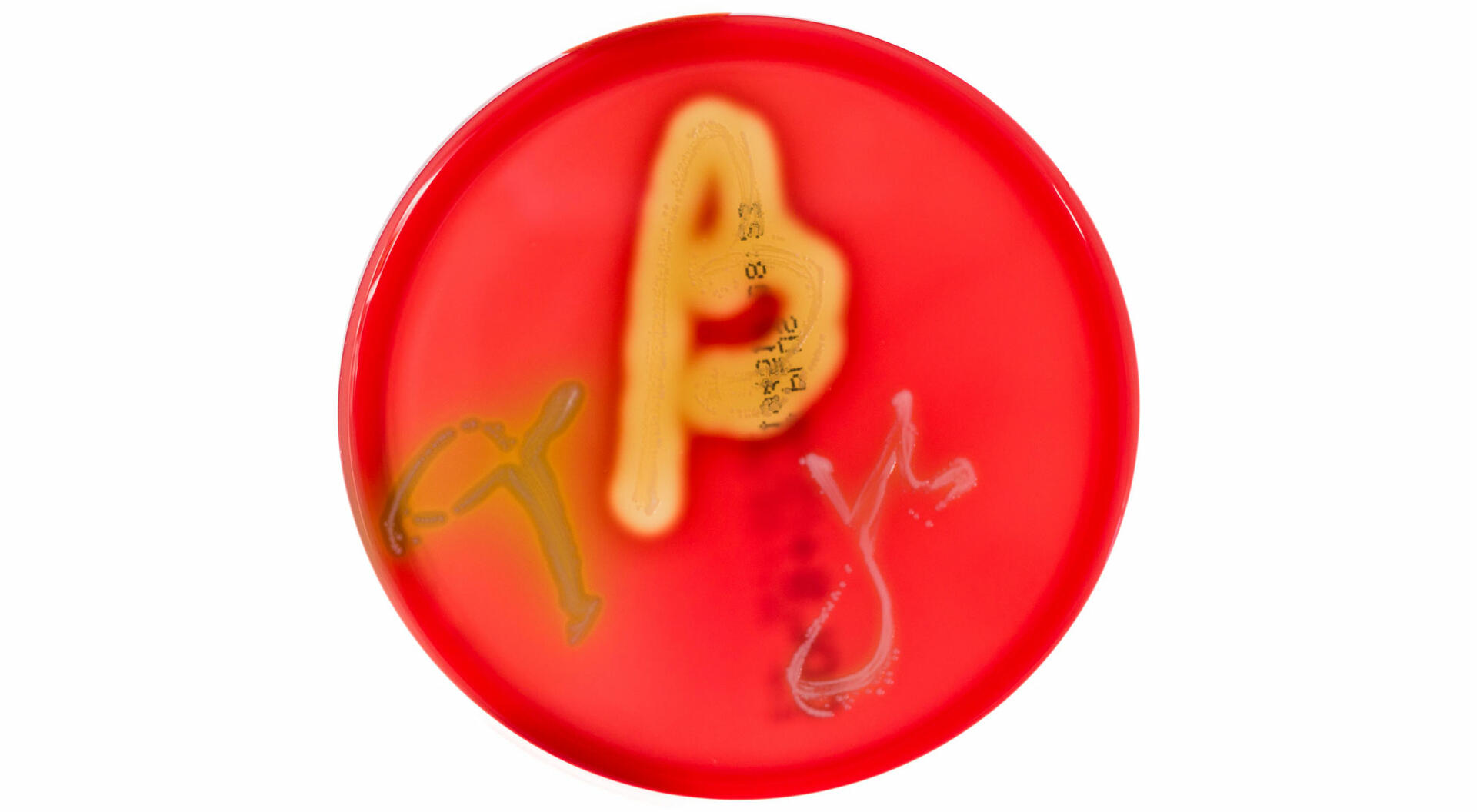
Media that are both selective and differential also exist. A famous example is the MacConkey agar, which contains crystal violet dye and bile salts, preventing the growth of Gram-positive bacteria. As it also contains lactose, Gram-negative, non-lactose fermenting species will not change the color of the agar plate, whereas Gram-negative lactose fermenting species will grow in red or pink colonies. A common application for the MacConkey agar is the differentiation of bacteria causing gastroenteritis.18
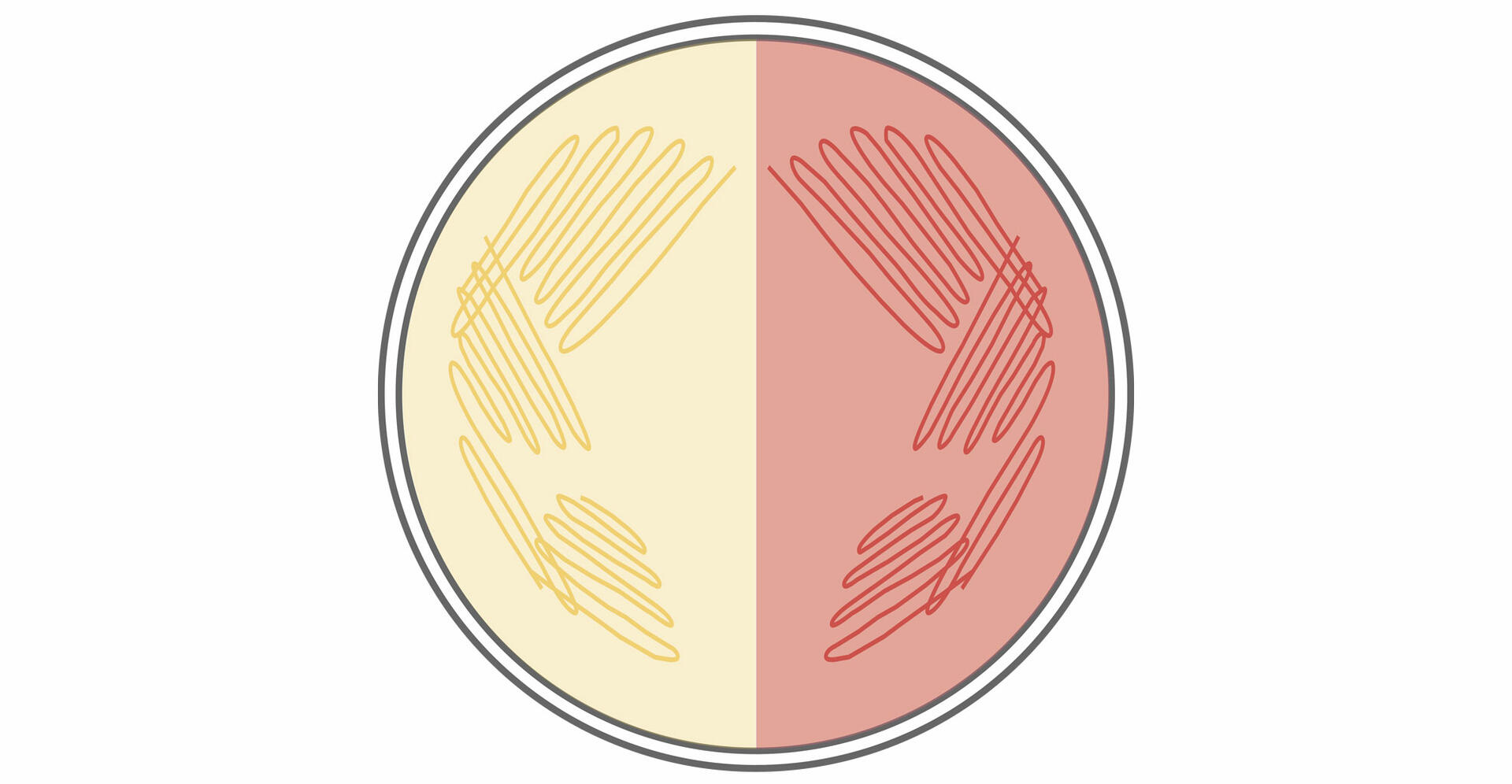
The final type of medium that we'd like to address in this article is the enriched medium. In contrast to selective media that suppress the growth of unwanted bacteria, enriched media contain supplements such as blood, serum or egg yolk that enhance the growth of fastidious bacteria that can be difficult to culture.19
Bacterial growth curve
When bacteria are cultured in liquid or broth media, they generally all follow the same growth pattern, known as the bacterial growth curve. As you can see in the figure below, this can be divided into four phases.
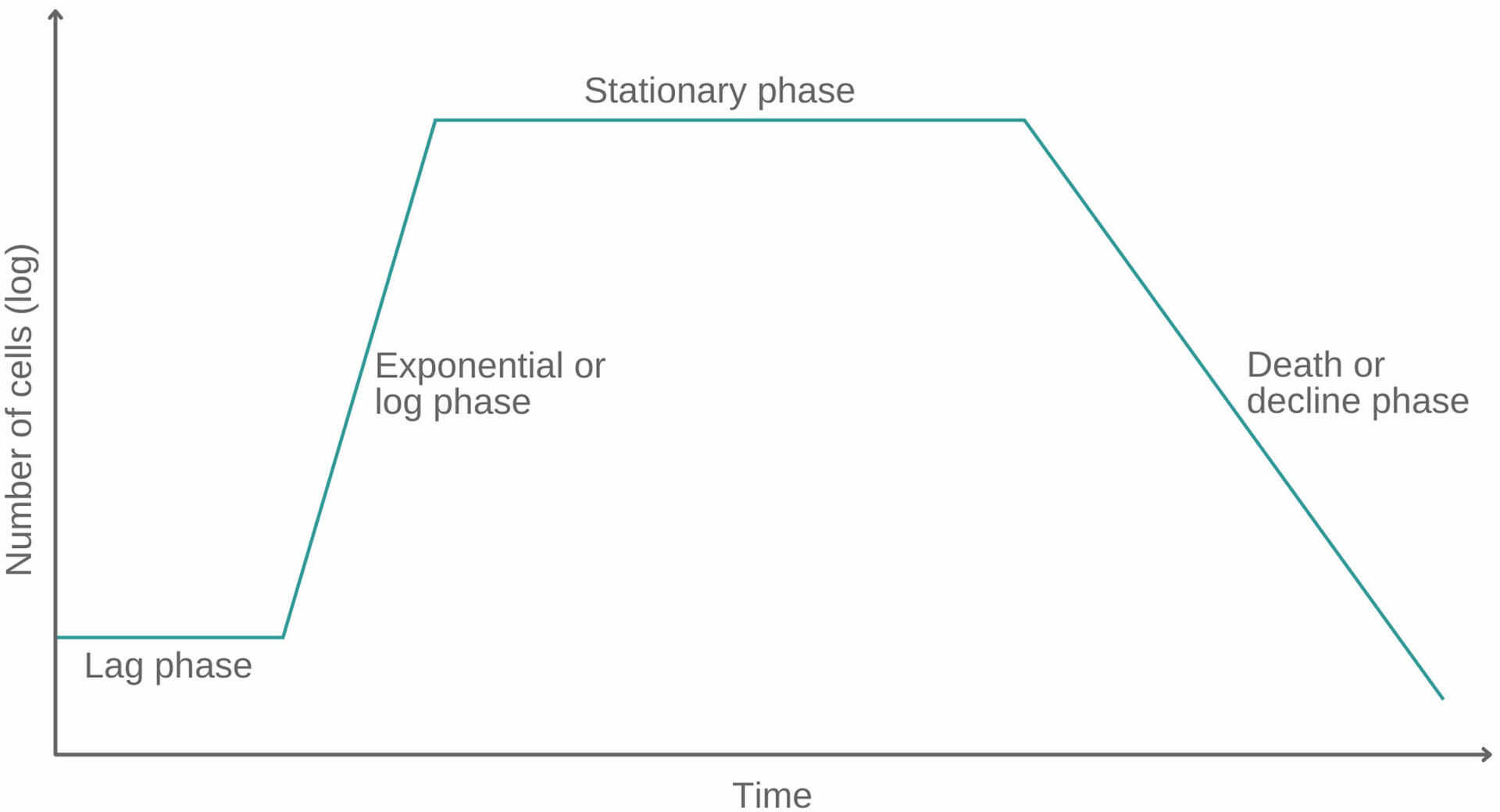
Lag phase
During the lag phase, bacteria are getting used to their new environment, and their number remains stable.16
Exponential or log phase
Bacteria reproduce through binary fission during the exponential or log phase, resulting in an exponential increase in number.16
Stationary phase
Sooner or later, the nutrients in the culture medium become exhausted, waste products accumulate, and space becomes scarce. This results in growth stagnating and the curve flattening.16
Death or decline phase
Ultimately, the bacterial population will start to shrink. However, the number of viable bacteria in a culture will rarely be zero, as some cells will always mutate or enter a dormant state.16
Whether or not a similar growth pattern also exists for bacteria grown on solid media still needs to be determined.20 However, sooner or later, the death or decline phase will occur, because nutrients will eventually be used up, too many waste products will accumulate, the space for further growth will be limited, or the medium will start to dry out. Therefore, bacterial cultures need to be subcultured regularly if you want them to continue to thrive.
To subculture bacteria growing in a liquid medium, aspirate a small portion and transfer it to a container with fresh culture medium. To subculture bacteria growing on a solid medium, use a loop to pick up a bacterial colony, then use it to inoculate a fresh culture medium.
How to get a pure culture
Besides subculturing, the isolation of a pure culture from a mixed population is a common technique in bacterial cultivation. Most samples contain at least a few different bacterial species and strains. However, to perform an experiment on a specific bacterial species or strain, you need to obtain a pure culture. Moreover, one of the criteria that must be met to register a new bacterial species is to grow it as a pure culture.3
Several techniques are available to obtain a pure culture from a mixed sample. You could, for example, use a specialized culture medium, such as the selective medium described above. Two other common methods that we'd like to highlight in this article are the ‘streak’ and ‘pour’ plate methods.
Streak plate method
For the streak plate method, bacteria are thinned out over the surface of an agar plate. After incubation, confluent growth can be observed in those parts of the plate where the cells weren't sufficiently separated; isolated colonies will have formed where individual bacterial cells were well-spaced from others.21 One of these isolated colonies can then be picked and subcultured to obtain a pure culture.
A commonly used approach is the four quadrant streak method, which consists of the following steps:22
- Inoculate the first quadrant of an agar plate.
- Streak the bacteria in quadrant two, overlapping quadrant one for two to three streaks.
- Streak the bacteria in quadrant three, overlapping quadrant two for two to three streaks.
- Streak the bacteria in quadrant four, overlapping quadrant three for two to three streaks, and incubate the plate.
Please note that you need to sterilize the inoculating loop between the different steps by flaming it with a Bunsen burner.
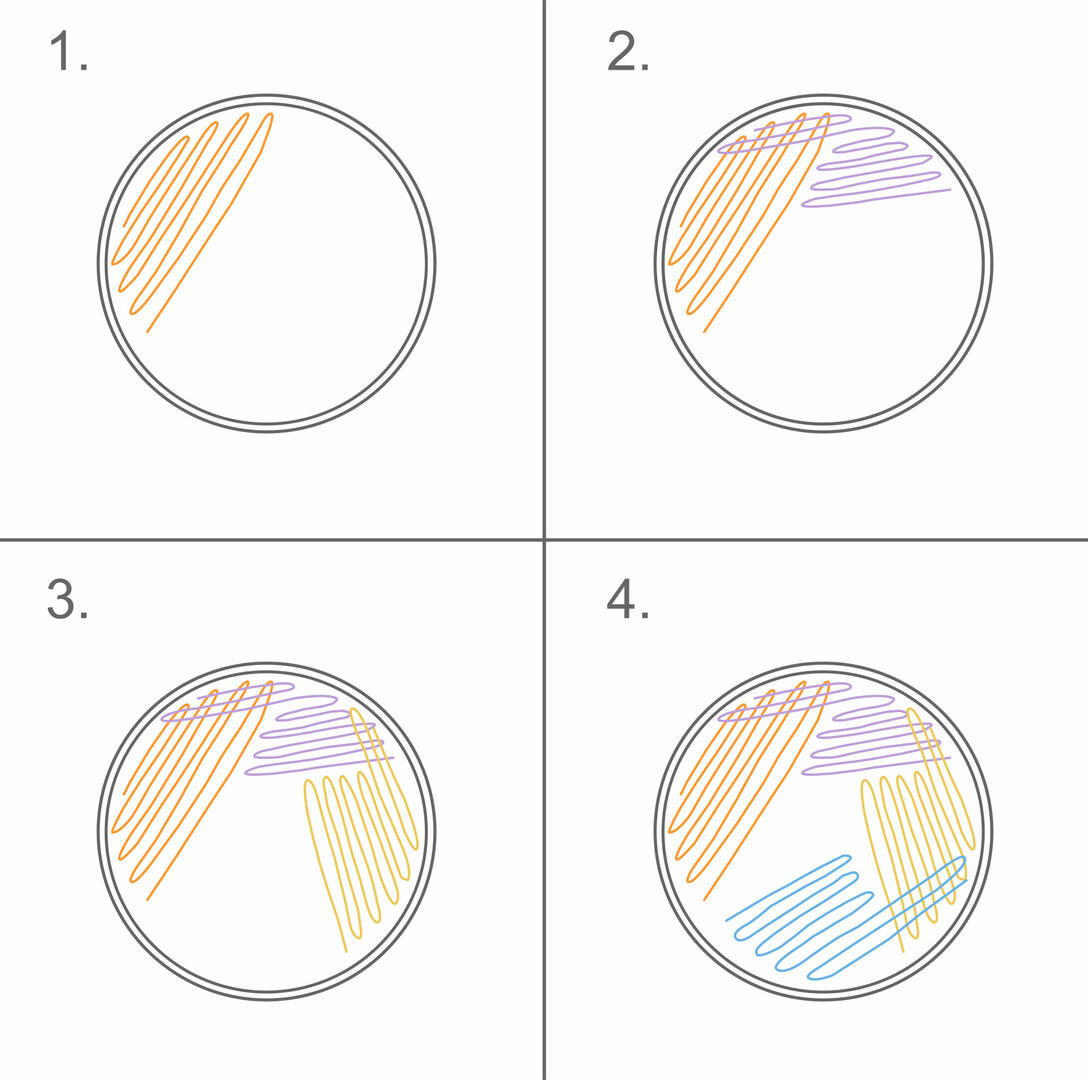
After incubation, your plate should show isolated colonies in the fourth quadrant where bacteria have been sufficiently thinned out:
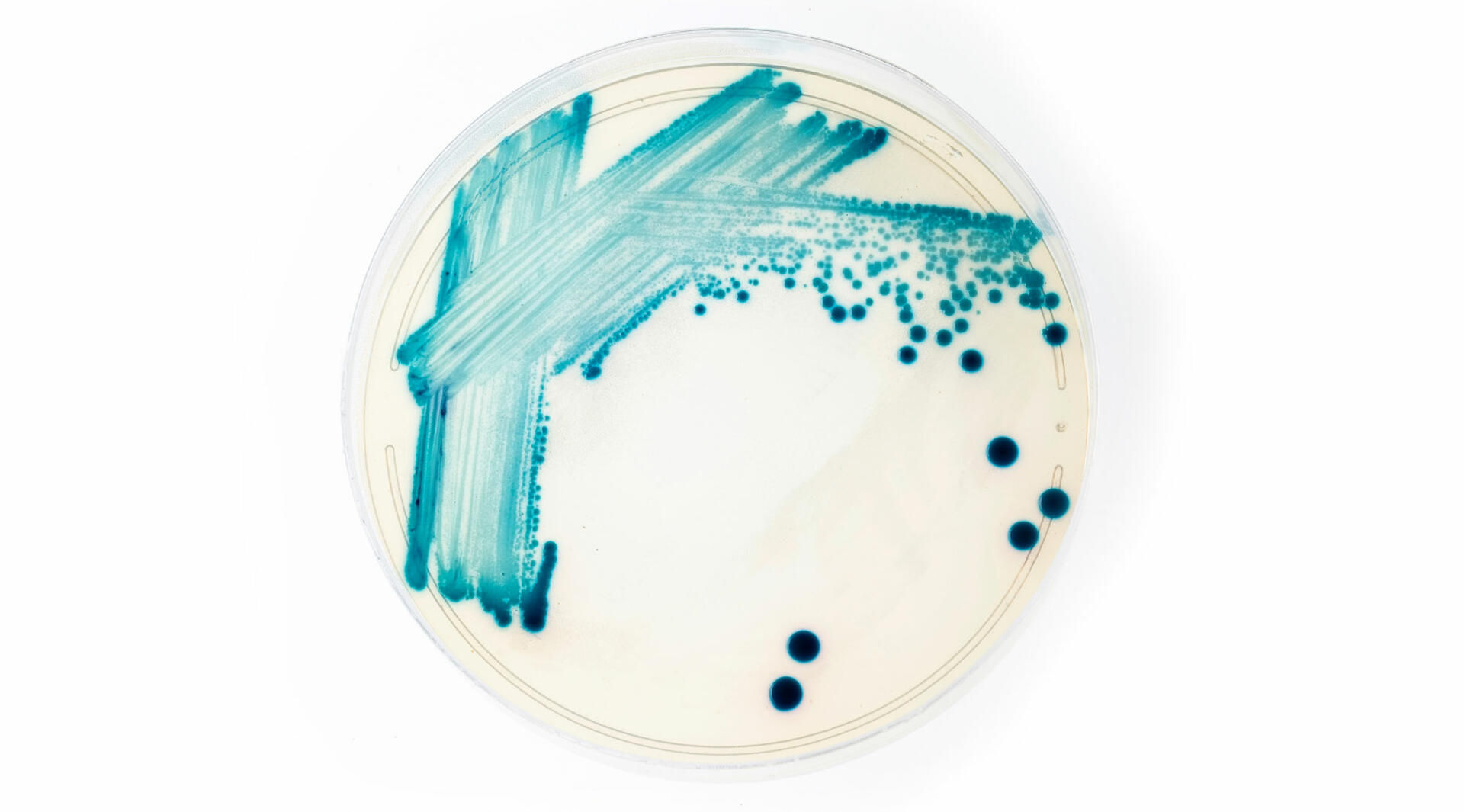
Pour plate method
If you want to obtain a pure bacterial culture using the pour plate method, you need to incubate several Petri dishes with different concentrations of a mixed sample. In some plates, the bacterial concentration will be too high, and confluent growth will be observed, whereas other plates will have just the right concentration to allow for the growth of isolated colonies that can be picked and subcultured.
The individual steps of the pour plate method are as follows23:
- Prepare a serial dilution of your mixed sample.
- Transfer 1 ml of each dilution into a separate Petri dish.
- Pour molten agar into the Petri dishes.
- Rotate the plates to ensure mixing of the sample and agar.
- Incubate the plates.
The pour plate method can also be used to determine the number of viable bacteria in a sample. Simply count the number of colonies formed during incubation and multiply by the dilution factor to obtain the bacterial concentration per milliliter of sample.24
Troubleshooting tips
As with every lab workflow, several things can go wrong when culturing bacteria. The most common problems are contamination and the bacteria of interest not growing at all. The tips in this section might help if you ever encounter either of these issues.
Contamination
To prevent contamination, always use good aseptic techniques when handling bacterial cultures. This means that you should wear clean gloves and work in a biosafety cabinet or laminar flow hood to protect your bacterial cultures from aerosols. If working in a hood is not possible, open your tubes and Petri dishes next to a flame. Moreover, sample containers and inoculated tubes and plates should be kept closed whenever possible, and your equipment should be sterile; either use single use disposables or re-sterilize your equipment, for example, by passing it through the flame of a Bunsen burner. Finally, keep your worksurface clean by disinfecting it before and after every experiment.25
Bacteria of interest don't grow
If your bacteria of interest don't grow, you should first check whether the growth conditions of your target species or strain were met. If you're trying to grow bacteria from clinical samples, double-check whether an antibiotic treatment killing the bacteria of interest took place before sampling.25 Another issue might be overgrowth. If you're working with a mixed sample, and trying to isolate bacterial species that grow rather slowly, their presence could be masked by a rapidly growing species. In this case, using selective culture media (described above) and adjusting the growth conditions to provide your species of interest with an ideal environment might help.25
Conclusion
Bacteria grow literally everywhere but, if you want to culture a specific species or strain in vitro, it can be a challenge to provide a suitable environment. In this blog, we’ve covered important parameters to take into account – such as the right oxygen concentration and the availability of essential nutrients – discussed when to use which type of medium, and outlined the importance of subculturing bacteria. We also explained how to obtain pure cultures from mixed samples, and provided some troubleshooting tips.
If you have additional questions regarding bacterial cultures, don't hesitate to leave a comment below.


